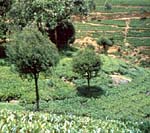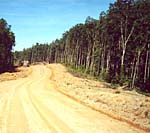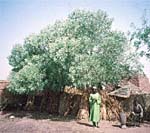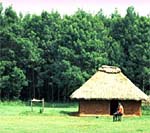|
|
|
|
The biological diversity of the Australian Acacia flora represents a vast economic, environmental and social resource. Species occur in all climate regions of Australia and show a wide range of ecological tolerances. Rhizobium nodules associated with their roots fix atmospheric nitrogen (see Brockwell et al. 2005 for review). In cultivation most Australian species are easy to propagate and often show good survival and rapid growth. Overseas, several species are grown in large plantations to meet the demand for industrial wood and tannin-rich bark, while others provide a source of fast-growing firewood in developing countries. In Australia, acacias are mainly grown in amenity and land rehabilitation plantings (cf. AcaciaSearch project). As exotics, Australian acacias are planted in over 70 countries and cover about 2 million hectares (Maslin & McDonald, 1996; Turnbull et al., 1998a). Despite the large number of species in the genus, relatively few are intensively cultivated, suggesting that the potential of many species remains unexplored.

Acacia mearnsii used for shade in tea estates, India
© CSIRO Forestry and Forest Products
Good taxonomy is needed to facilitate appropriate utilisation research, especially in a large, species-rich genus such as Acacia. This point was made by Burgman et al. (2000) with regard to the setting of conservation priorities and by McDonald et al. (1996) in relation to domestication of tropical dry-zone acacias (see also Maslin 2002). Good taxonomic research provides the means whereby information on taxa can be accurately exchanged. One of the objectives of the Flora of Australia series, including the present volumes and the accompanying WATTLE CD, is to summarise the most recent results of taxonomic research. These works provide the essential basis for effective utilisation of the biota. Utilisation research has also resulted in the discovery of new taxa and species complexes in Acacia (e.g. Boland & Midgley, 1983; Maslin & Thomson, 1992; McDonald & Maslin, 1997; McDonald et al., 1998; McDonald & Maslin, 2000).
Traditional Aboriginal knowledge of Acacia species has also been an invaluable source of information for utilisation. Aborigines have long used species of Acacia as a source of food and medicine, tools and weapons, and in ritual practices (Aboriginal Communities of the Northern Territory, 1993; Latz, 1995; Bindon, 1996). Historically, a number of Australian botanists, notably J. H. Maiden, were proactive in documenting the use of the Australian Acacia flora by Australian Aborigines and early European settlers, and in promoting its wider utilisation (e.g. Maiden 1889, 1905). This knowledge base has facilitated the utilisation of a number of species.
Some of the main uses of Australian acacias in Australia and overseas are reviewed under the headings cut flowers & oils, wood products, tannins, edible seeds, fodder, land rehabilitation, weediness and genetic evaluation; for more detailed information see Maiden (1889), Boland et al. (1984), Boland (1989), House & Harwood (1992); Thomson et al. (1994), Searle (1996), Doran & Turnbull (1997), Turnbull et al. (1998b), Maslin et al. (1998), Midgley & Turnbull (2003) and Midgley et al. (2003).
(Text on this and subsidiary pages has been adapted from Utilisation of Acacias by M.W.McDonald, B.R.Maslin & P.A.Butcher, Flora of Australia vol. 11A Mimosaceae, Acacia Part 1, pp. 30–40, 2001)
Overview of utilisation of Australian species of Acacias.
Some useful links
Acacia World
This useful website by Wolf-Achim Roland provides information on the economic value of Acacia in southern France, including horticulture, floriculture, the perfume and soap industries and Mimosa festivals.
FACT Net
An international network of community groups, development workers, tree breeders, researchers, students, and farmers of 2,000 partners in 100 countries with a shared interest in the use of multipurpose trees to improve the soil, protect the environment, and enhance the well-being of farm families and other land users. FACT Net closed in 1999 but Winrock International’s Forestry and Natural Resource Management Program maintains the web site.
International Union of Forest Research Organizations (IUFRO)
The Working Party 2.08.02 of IUFRO is interested in research on nitrogen-fixing genera, particularly those that are suitable for soil stabilization, wind protection, for use on poor soils, wetlands and in dry regions of the world. Research interests include the biology of nitrogen fixation and optimization of growth and adaptability utilizing this property in domesticated species. Many species are multipurpose and important for farm forestry, agroforestry, pulpwood, firewood and charcoal and other products such as fodder for animals. Improvement strategies include propagation strategies, selection for pest resistance, disease resistance, and multiple traits, combined with appropriate silvicultural methods. Among its activities is the publication of newsletter NFT News — Improvement and Culture of Nitrogen Fixing Trees, providing PDF downloads of published papers.
Flora Bank
Flora Bank provides information that aims to improve the availability and quality of native seed for revegetation and conservation purposes in Australia.
Rural Industries Research & Development Corporation
Visit this site and conduct a search for Acacia to obtain reports and other documents relating to some commercial prospects, for example, the fodder value of A. saligna, the potential of Acacia for cut flower and foliage production, wattle seed production in low rainfall areas, Acacias as hosts for Quandong production, potential for tannin and fuelwood production of some bipinnate-leaved Acacias, silviculture and management of Blackwood (A. melanoxylon), and more.
Australian Biological Resources Study (ABRS)
“Species Bank” (developed by ABRS) provides information on some commonly utilised Acacias, including descriptions, photos, distribution maps and notes on their ecology, biology and utilisation.
FAO (Food and Agriculture Organization of the United Nations) Crop and Grassland Service
This site provides information for selected Australian and non-Australian Acacia species that may have some utilisation value in tropical grasslands.
Publications available on the net
Biology of Acacia. Advances in Legume Systematics Part 11. Australian Systematic Botany vol. 16, no. 1 (2003).
This volume includes 13 papers on Acacia that were presented at the Fourth International Legume Conference in Canberra (2-6 July, 2001); it can be purchased from CSIRO Publishing and (free) abstracts of the papers are available for download.
The conservation and utilisation potential of Australian dryland Acacias. Conservation Science Western Australia vol. 4, no. 3 (2002).
This volume contains the proceedings of a Symposium held in Dalwallinu, W.A. in 2001. The aim of the Symposium was to explore the role of Acacias in helping solve some of the serious problem currently confronting many rural communities and ecosystems, both within Australia and abroad. The volume is available for purchase at a cost of $22 (plus postage) from the Shire of Dalwallinu (contact: dallyshire@wn.com.au). PDF versions of the individual published papers are available elsewhere on WorldWideWattle.
References
Aboriginal Communities of the Northern Territory (1993), Traditional Aboriginal Medicines in the Northern Territory of Australia. Conservation Commission of the Northern Territory of Australia, Darwin.
Bindon, P. (1996), Useful Bush Plants. Western Australian Museum, Perth.
Boland, D.J. (ed.) (1989), Trees for the Tropics. Growing Australian Multipurpose Trees and Shrubs in Developing Countries. ACIAR Monograph No. 10. Australian Centre for International Agricultural Research, Canberra.
Boland, D.J. & Midgley, S.J. (1983), Acacia ‘blayana’ A.B.Court – a new Australian tree with a future?, Forest Genetic Resources Information 12: 21–23.
Brockwell, J., Searle, S., Jeavons, A.C. and Maayers, M. (2005). Nitrogen fixation in Acacias: an Untapped Resource for Sustainable Plantations, Farm Forestry and Land Reclamation. pp. 132. (Australian Centre for International Agricultural Research: Canberra.). This book may be viewed and/or purchased online by visiting ACIAR Books Online.
Burgman, M.A., Maslin, B.R., Andrewartha, D., Keatley, M.R., Boek, C. & McCarthy, M. (2000), Inferring threat from scientific collections: power tests and an application to Western Australia Acacia species, in S.Ferson & M.Burgman (eds), Quantitative Methods for Conservation Biology, pp. 7–26. Springer, New York.
Doran, J.C. & Turnbull, J.W. (1997), Australian Trees and Shrubs: Species for Land Rehabilitation and Farm Planting in the Tropics. ACIAR Monograph No. 24. Australian Centre for International Agricultural Research, Canberra.
House, A.P.N. & Harwood, C.E. (eds) (1992), Australian Dry-Zone Acacias for Human Food. CSIRO Division of Forestry, Australian Tree Seed Centre, Canberra.
Latz, P.K. (1995), Bushfires and Bushtuckers: Aboriginal Plant Use in Central Australia. IAD Press, Alice Springs.
Maiden, J.H. (1889), Useful Native Plants of Australia. Technological Museum of New South Wales, Sydney.
Maiden, J.H. (1905), Wattles and Wattle Barks, Being Hints on their Conservation and Cultivation Together with Particulars of their Value. 3rd Edn. William Applegate Gullick, Government Printer, Sydney.
Maslin, B.R (2002). Is systematics critical for effective utilisation and conservation of Acacia? Conservation Science Western Australia 4(3): 1–9.
Maslin, B.R. & McDonald, M.W. (1996), A Key to Useful Australian Acacias for the Seasonally Dry Tropics. CSIRO, Australia.
Maslin, B.R. & Thomson, L.A.J. (1992), Re-appraisal of the taxonomy of Acacia holosericea, including the description of a new species, A. colei, and the reinstatement of A. neurocarpa, Austral. Syst. Bot. 5: 729–743.
Maslin B.R., Thomson L.A.J., McDonald, M.W. & Hamilton-Brown S. (1998), Edible Wattle Seeds of Southern Australia. A Review of Species for Use in Semi-arid Regions. CSIRO Forestry and Forest Products/Western Australia Department of Conservation and Land Management (CALM), CSIRO Publishing.
McDonald, M.W. & Maslin, B.R. (1997), A reappraisal of Acacia cowleana and allied taxa, including the description of a new species, A. elachantha, from tropical dry-zone of Australia, Austral. Syst. Bot. 10: 303–320.
McDonald, M.W. & Maslin, B.R. (2000), A Revision of the Salwoods: Acacia aulacocarpa Cunn. ex Benth. and its allies (Leguminosae: Mimosoideae: section Juliflorae), Austral. Syst. Bot. 13: 21–78.
McDonald, M.W., Harwood C.E. & Whitfeld S.J. (1998), Morphological variation in Acacia tumida F. Muell. ex Benth. and implications for its utilisation, in J.W. Turnbull, H.R. Crompton & K. Pinyopusarerk (eds.), Recent Developments in Acacia Planting. Proceedings of an international workshop held in Hanoi, Vietnam, 27–30 October, 1997. ACIAR Proceedings No. 82, pp. 341–346. Australian Centre for International Agricultural Research, Canberra.
McDonald, M.W., Maslin, B.R. & Harwood, C.E. (1996), Taxonomic studies of tropical dry zone Acacia species facilitate their domestication, in M.J.Deiters, A.C.Matheson, D.G.Nikles, C.E.Harwood & S.M.Walker (eds), Tree Improvement for Sustainable Tropical Forestry. Proceedings of QFRI-IUFRO Conference. 27 October–1 November 1996, Caloundra, Queensland, Australia, pp. 96–98. Queensland Forestry Research Institute, Gympie, Queensland.
Midgley, S.J. and Turnbull, J.W. (2003). Domestication and use of Australian Acacias: an overview. Australian Systematic Botany.16(1): 89-102. An abstract of this paper (together with a provision to purchase the whole article) is available from CSIRO Publishing.
Midgley, S.J., Turnbull J.W. and Pinyopusarerk, K. (2003). Industrial Acacias in Asia: Small Brother or Big Competitor? In Wei, R.-P. and Xu, D. (eds) Eucalyptus Plantations - Research, Management and Development, Proceedings. of International Symposium on "Eucalyptus plantations", Guangzhou/Zhaoqing, China, 1-6 September 2002. Singapore.
Searle, S.D. (1996), Wood and non-wood uses of temperate Australian acacias, Anon. (ed.), Farm Forestry and Plantations: Investing in Future Wood Supply. Proceedings of 1996 Australian Forest Growers Conference, Mount Gambier, South Australia, 9–12 September 1996, pp. 256–266.
Thomson, L.A.J., Turnbull, J.W. & Maslin, B.R. (1994), The utilization of Australian species of Acacia, with particular reference to those of the subtropical dry zone, J. Arid Environm. 27: 279–295.
Turnbull, J.W., Midgley, S.J. & Cossaltar, C. (1998a), Tropical acacias planted in Asia: an overview, in J.W.Turnbull, H.R.Crompton & K.Pinyopusarerk (eds), Recent Developments in Acacia Planting. Proceedings of an international workshop held in Hanoi, Vietnam, 27–30 October, 1997. ACIAR Proceedings No. 82, pp. 29–35. Australian Centre for International Agricultural Research, Canberra.
Turnbull, J.W., Crompton, H.R. & Pinyopusarerk, K. (eds) (1998b), Recent Developments in Acacia Planting. Proceedings of the Third International Acacia Workshop, Hanoi, 27–31 Oct 1997. ACIAR Proceedings No. 82. Australian Centre for International Agricultural Research, Canberra. 383 pp.


